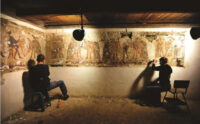 A study of early Colonial wall paintings found in private homes in Chajul, Guatemala, has revealed they were painted by local Ixil Maya artists using a combination of traditional techniques and European motifs. They are rare surviving glimpses into the shift in cultural practice and iconography from the pre-Hispanic Maya to the Spanish Colony.
A study of early Colonial wall paintings found in private homes in Chajul, Guatemala, has revealed they were painted by local Ixil Maya artists using a combination of traditional techniques and European motifs. They are rare surviving glimpses into the shift in cultural practice and iconography from the pre-Hispanic Maya to the Spanish Colony.
Chajul was an important regional center before it was conquered by Spain in 1530. A vase from the Late Classic period (600-800 A.D.) names a high official of the Chajul king, so it was a politically prominent city with its own dynasty of rulers. Most of the ancient city is believed to lie underneath the modern city, with only a few Maya structures marking the perimeter of a ballcourt found northwest of modern Chajul.
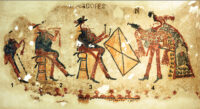 Colonial-era murals were first discovered in Chajul during a house renovation in 2003 and archaeologists from the Institute of Anthropology and History of Guatemala (IDAEH) determined they dated to the Colonial period (1524-1821). The largest and best-preserved wall paintings were discovered in the home of the Asicona family who still live there today. It was dubbed House 3.
Colonial-era murals were first discovered in Chajul during a house renovation in 2003 and archaeologists from the Institute of Anthropology and History of Guatemala (IDAEH) determined they dated to the Colonial period (1524-1821). The largest and best-preserved wall paintings were discovered in the home of the Asicona family who still live there today. It was dubbed House 3.
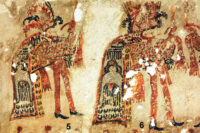 House 3 is an adobe brick structure bound with a mixture of pine needles and mortar. The interior walls were covered with white stucco and murals painted on the surface. The presence of old murals was first detected in the 1990s but they were only small glimpses of the still-hidden whole. It was only when owner Lucas Asicona Ramírez removed the outer layers of plaster on the wall in the course of replacing the roof that the full surviving murals were revealed.
House 3 is an adobe brick structure bound with a mixture of pine needles and mortar. The interior walls were covered with white stucco and murals painted on the surface. The presence of old murals was first detected in the 1990s but they were only small glimpses of the still-hidden whole. It was only when owner Lucas Asicona Ramírez removed the outer layers of plaster on the wall in the course of replacing the roof that the full surviving murals were revealed.
The murals decorate the north, east and west walls of the central room of House 3. The original south wall was demolished long ago, but it probably had murals as well. They depict musicians playing instruments, both local 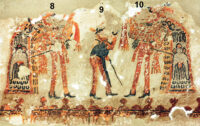 and Spanish-introduced, dancers, some wearing European clothes, some wearing mixed Indian-Spanish fashions. Chajul locals believe the murals represent dances, either the Baile de la Conquista (Dance of the Conquest), or the Baile de los Moros y Cristianos (Dance of the Moors and Christians), which are performed stories from the Spanish conquest of the Maya highlands.
and Spanish-introduced, dancers, some wearing European clothes, some wearing mixed Indian-Spanish fashions. Chajul locals believe the murals represent dances, either the Baile de la Conquista (Dance of the Conquest), or the Baile de los Moros y Cristianos (Dance of the Moors and Christians), which are performed stories from the Spanish conquest of the Maya highlands.
In 2011 almost all the houses with murals were photographed and documented. In 2014 the large, well-preserved murals in House 3 were 3D laser-scanned. In 2015, Polish researchers undertook a physical and chemical study and conservation of the extensive murals in House 3.
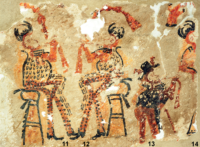 Using techniques including scanning electronic microscopy, X-ray powder diffraction and gas chromatography-mass spectrometry, researchers found that the methods and materials used to make the murals were the same ones used for centuries before the Spanish conquest. The color palette is type of pre-Hispanic Maya wall paintings found in the Maya Lowlands — white lime, ochre, Maya blue. The blue no longer looks blue today; it’s more like grey. The fading was caused either by a conservation problem, and/or a decline in the color-fastness of the pigment due to the loss of traditional knowledge about how to prepare it, specifically which mineral was the source of the blue color and what temperature to heat it. The underlying stucco is also the same type — local calcium carbonate mixed with ground seashells — as the stucco in widespread use during the Maya Postclassic period.
Using techniques including scanning electronic microscopy, X-ray powder diffraction and gas chromatography-mass spectrometry, researchers found that the methods and materials used to make the murals were the same ones used for centuries before the Spanish conquest. The color palette is type of pre-Hispanic Maya wall paintings found in the Maya Lowlands — white lime, ochre, Maya blue. The blue no longer looks blue today; it’s more like grey. The fading was caused either by a conservation problem, and/or a decline in the color-fastness of the pigment due to the loss of traditional knowledge about how to prepare it, specifically which mineral was the source of the blue color and what temperature to heat it. The underlying stucco is also the same type — local calcium carbonate mixed with ground seashells — as the stucco in widespread use during the Maya Postclassic period.
Our research to date, including interviews with Chajul inhabitants about local history and tradition, suggests that houses with murals were originally owned by important members of the local community—possibly members of the cofradías. These individuals were involved in the organisation of religious events, both those connected with Catholicism and those linked with costumbre (or Maya spirituality, related to the cult of the Maya pre-Columbian calendar and to agrarian rituals). Prior to the recent civil war in Guatemala (c. 1960–1996), there were approximately 10 cofradías in Chajul, although their number has decreased in recent years. The rooms with paintings probably served as places for important cofradía meetings and dances (cf. Howell 2004: 35).
Although the murals are currently located in domestic spaces, it is possible that in the past, painted rooms (or whole houses) might have played a different role. According to Lucas Asicona, the three rooms of house 3 had different functions in the early twentieth century. The northernmost room served as a space for receiving visitors; the central room, with the murals (at that time completely covered by later stucco), served as a place for special events, such as meetings, ceremonies and dances for the cofradía. Finally, the southernmost room was a kitchen and living room. A large patio in front of the house provided another space for dances. This division seems to reflect the original seventeenth-/eighteenth-century layout and function of the house. It should be noted that some other Chajul city houses with wall paintings have been—or still are—used as meeting places for cofradía members. Thus, it is very plausible that most, if not all, of the houses with murals belonged to cofradía members and served as important places for meeting and dance. As such, the paintings from these locations may commemorate special events, particularly dances, practised by these important religious and social organisations.
Chajul, Guatemala is really in the back country, end of the road kind of place. There are few ruins in the area because most of the precolonial building was done in wood, in the Highland area. The Maya culture is still very strong in the area, well worth the trip if you are ever in Guatemala.
Just from the European dress and beard styles I would guess the date of the paintings to the 18th and probably late 18th century. The short jackets and chin beards/side burns look to me to be the style of the last few decades of the 18th century and possibly the first decade of the 19th century. I find it interesting that the Maya ceremonial dress survived that late.
I would have loved to see what the houses themselves look like. Very neat. I am happy the owner found value in the find!